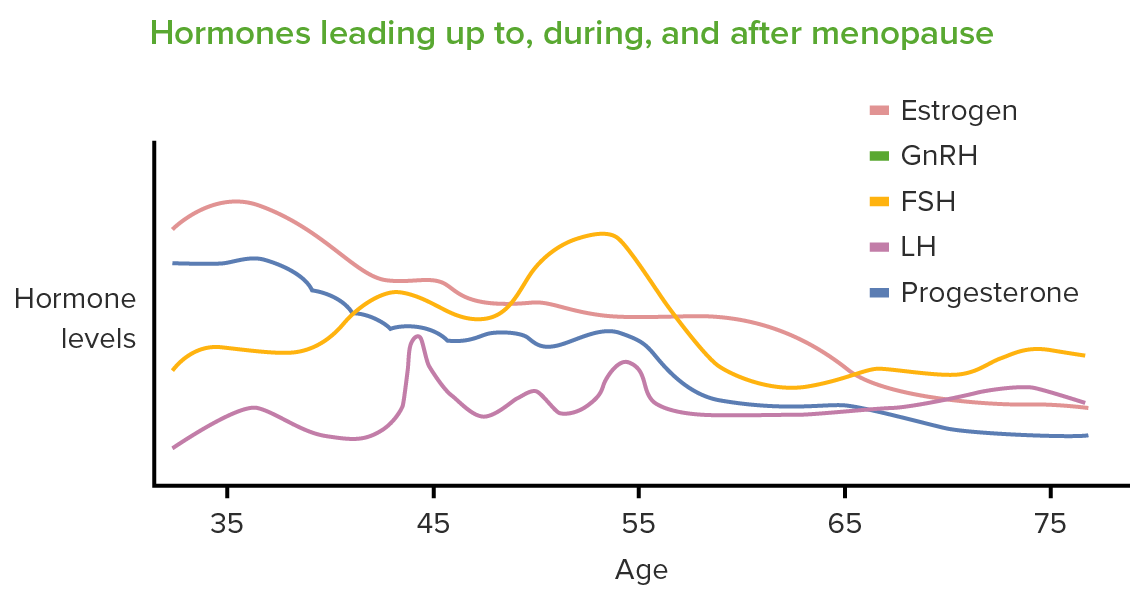Playlist
Show Playlist
Hide Playlist
Postmenopausal Bleeding
-
Slides PostmenopausalBleeding Menopause.pdf
-
Download Lecture Overview
00:01 Hello. Now, we'll review postmenopausal bleeding, causes, evaluation, and management. Remember, postmenopausal bleeding is never normal. 00:12 Let's discuss when menopause occurs. 00:16 We have another lecture about menopause if you'd like to review that. 00:20 The average age of menopause is 51 years old. 00:24 Remember, this is a retrospective diagnosis and requires no menstrual cycles for at least 1 year. Any bleeding that occurs after the menopause requires a prompt evaluation. This is never a normal phenomenon. 00:40 Let's now review the epidemiology of postmenopausal bleeding in the US. 00:46 The majority of patients will present to you a postmenopausal bleeding due to atrophic changes in vagina or the endometrium. 00:53 However, remember that cancer of the endometrium can occur and it's the most common type of gynecologic cancer in the US. 01:02 Depending on age and risk factors, that is older age and risk factors such as obesity and chronic anovulation, 1-14% of patients will have endometrial cancer. 01:14 Let's now discuss the common causes of postmenopausal bleeding. 01:19 Endometrial atrophy is the most common cause. 01:22 After the menopause, which again occurs at 51 years of age on average, the endometrium may become too thin as result of low estrogen levels However, polyps are another cause. 01:34 Polyps are usually a noncancerous growth of tissue in the endometrium that actually can cause some bleeding. 01:41 Endometrial hyperplasia is another common cause of postmenopausal bleeding. 01:47 Essentially, the lining of the uterus thickens and that leads to hyperplasia which is the precursor to endometrial cancer. 01:54 Endometrial hyperplasia is more common in obese women as they have peripheral aromatization of androgen making estrogens and they have unopposed estrogenic state. 02:05 ACOG recommends that all patients be evaluated with a transvaginal ultrasound or an endometrial biopsy. 02:14 Let's now discuss the management of postmenopausal bleeding. 02:21 If a patient has endometrial carcinoma, they should be referred to a GYN oncologist and have a hysterectomy. Likely these patients will have already be of postmenopausal age but young patients can even have endometrial carcinoma. 02:36 Endometrial hyperplasia is typically treated with progestins that can be in the form of a levonogestrel IUD or oral progestins. 02:45 Atrophy is typically treated with hormone replacement therapy, either transdermally or locally in the vagina. 02:53 If polyps are present, they should be removed hysteroscopically which is a same day procedure and is not terribly invasive. 03:02 For more information about polyps, look at the lecture regarding AUB, specifically AUBP. 03:08 Let's now talk about Tamoxifen use in the postmenopausal women. 03:14 Some women in their postmenopause and perimenopause can still be on Tamoxifen therapy as result of having ER-positive breast cancer. 03:21 This has been known to cause endometrial hyperplasia but we shouldn't just screen patients who are on Tamoxifen unless they present with bleeding. 03:29 Let's now review what we've discussed. 03:34 Endometrial and vaginal atrophy are the most common cause. 03:37 Always evaluate postmenopausal bleeding, that means the patients requires a history physical exam and evaluation. 03:45 Transvaginal ultrasound and endometrial biopsy are both first line methods of evaluation as recommended by ACOG. 03:53 Persistent bleeding needs reevaluation despite initial benign findings as there may be another cause that can cause postmenopausal bleeding. 04:03 90% of endometrial cancer presents with postmenopausal bleeding and therefore it's important that we evaluate each incidence of postmenopausal bleeding. However, there are some patients who've undergone endometrial ablation and they may not present with bleeding. 04:19 Thank you for listening and good luck on your exam.
About the Lecture
The lecture Postmenopausal Bleeding by Lynae Brayboy, MD is from the course Menopause.
Included Quiz Questions
Which of the following investigations is recommended by the ACOG for postmenopausal bleeding?
- Endometrial biopsy
- Transabdominal ultrasound
- CT scan
- MRI
- Hormone levels
A patient who is 65 years old comes with postmenopausal bleeding. Which of the following is NOT a part of the differential diagnosis?
- Normal irregularity in menstrual cycles
- Endometrial polyp
- Endometrial hyperplasia
- Endometrial cancer
- Endometria atrophy
A 54-year-old breast cancer patient who is treated with Tamoxifen presents with postmenopausal bleeding. What the most likely cause of postmenopausal bleeding?
- Endometrial hyperplasia
- Endometrial atrophy
- Endometrial polyp
- Cervical cancer
- Idiopathic
Customer reviews
3,0 of 5 stars
| 5 Stars |
|
0 |
| 4 Stars |
|
0 |
| 3 Stars |
|
1 |
| 2 Stars |
|
0 |
| 1 Star |
|
0 |
love to have all causes to be in the same lecture atrophic vaginitis too , inofrmatiove , however searching for the clinical presentation features as well




